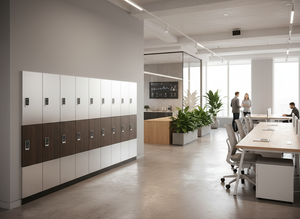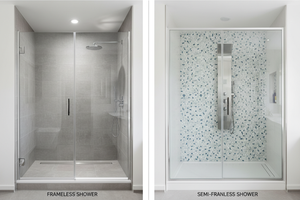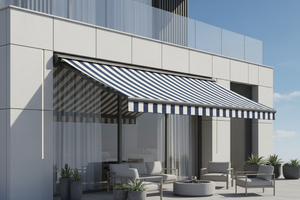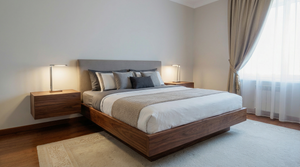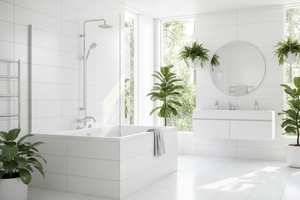Lockers: Complete Guide to Storage Solutions for Every Need

Whether you’re securing student belongings in a school hallway or protecting employee valuables in a corporate office, the right locker system can transform chaotic storage challenges into streamlined, secure solutions. Modern lockers have evolved far beyond simple metal boxes to become sophisticated storage systems that meet diverse needs across countless applications.
Locker solutions are available for sale in Australia, making it easy for Australian customers to find and purchase the right single door lockers for their needs.
This comprehensive guide will walk you through everything you need to know about lockers, from basic functionality to advanced features, helping you find the perfect storage solution for your specific requirements. We’ll explore different types, materials, security options, and configurations to ensure you make an informed decision that serves your facility for years to come. Lockers are available for sale and can be tailored to suit a variety of needs.
Checkout out these great lockers now!
What Are Lockers and Why Do You Need Them
A locker is fundamentally a secure storage compartment designed to protect personal belongings while providing individual access through various locking mechanisms. These storage solutions have become indispensable across numerous environments where people need safe, temporary, or long-term storage for their items.
The primary benefits of lockers include enhanced security for valuables, improved organization of space, maximum storage efficiency in limited areas, and controlled access that gives users peace of mind. Lockers offer efficient storage space for a wide range of environments, making them a versatile solution for organizing and safeguarding belongings. Unlike open storage systems, lockers provide a dedicated, lockable space that protects contents from theft, damage, and unauthorized access.
Today’s lockers serve countless applications across schools where students store books and personal items, gyms where members secure clothing and valuables during workouts, offices where employees house personal belongings in open workspace environments, hospitals where patients protect items during treatment, and industrial facilities where workers store tools and equipment.
The evolution from simple metal boxes to sophisticated storage systems reflects changing user needs and technological advances. Modern lockers now come in a variety of sizes to accommodate different storage requirements, and feature advanced locking mechanisms including digital keypads, RFID access, biometric systems, and electronic locks that use a keypad for PIN entry, RFID cards, or smartphone apps, offering enhanced security without physical keys. Materials have diversified beyond traditional steel to include plastic, wood, and specialized composites designed for specific environments.
Types of Lockers by Application
Understanding the different types of lockers available helps you choose the right solution for your specific environment and user needs. Each application presents unique requirements for size, security, materials, and features, and you can customise lockers to fit these unique needs.
School and Educational Lockers
Educational institutions require lockers that balance security, durability, and cost-effectiveness while accommodating diverse storage needs. These lockers are built to stand the test of time in busy school environments, ensuring they remain reliable and durable under regular use. Standard corridor lockers typically feature widths that provide adequate space for books, backpacks, coats, and personal items that students need throughout the school day.
PE and gym lockers within school premises often include ventilation features to handle sports equipment and damp clothing. These specialized units help prevent odors and moisture buildup that can occur when students store athletic gear. Staff lockers in faculty rooms typically offer enhanced security features and larger dimensions to accommodate professional materials and personal belongings.
The most common configurations in educational settings include single tier lockers standing full height for maximum storage capacity, and double tier arrangements with each compartment measuring half the height. This flexibility allows schools to accommodate varying student populations while making efficient use of available space.
Many schools today choose custom colours to match their institutional branding or create a more welcoming environment. Additionally, schools often request specific features like built-in hooks, shelving, and ventilation to meet their unique requirements.
Gym and Fitness Center Lockers
Fitness facilities present unique storage challenges that require specialized locker solutions. Full-length lockers provide essential space for hanging clothes and storing large items like gym bags, ensuring members can comfortably store their belongings during workouts.
Day-use lockers with coin-operated or digital locks serve casual visitors who need temporary, secure storage. These systems allow fitness centers to generate additional revenue while providing convenience for drop-in customers. Member lockers with rental agreements offer long-term storage for regular customers who prefer to leave certain items at the facility.
Specialized features common in gym environments include built-in benches for convenient changing, dedicated shoe storage compartments, and antimicrobial coatings that help maintain hygiene in high-moisture environments. Ventilation becomes particularly important in these settings to prevent odor buildup and maintain air circulation.
Many fitness centers also invest in charging capabilities for member devices, reflecting the modern need to keep phones and fitness trackers powered during workouts. These advanced features help facilities differentiate themselves and provide superior customer service.
Workplace and Office Lockers
Modern office environments increasingly rely on lockers to support flexible work arrangements and secure personal storage. Personal storage lockers provide employees with dedicated space for belongings in open office environments where traditional desk storage may be limited or non-existent.
Laptop and device storage lockers with integrated charging capabilities address the growing need to secure expensive electronics while keeping them powered and ready for use. These specialized units often feature cord management systems and ventilation to prevent overheating. Charging lockers provide secure storage along with built-in power outlets or USB ports, commonly found in schools and offices.
Mail and package lockers create secure delivery systems that protect incoming items while reducing the administrative burden on reception staff. These systems prove particularly valuable for offices that receive frequent deliveries or operate in buildings with limited reception coverage. Parcel lockers, as automated self-service units, provide secure retrieval of packages and are increasingly used in residential buildings and retail locations to enhance convenience and security.
Hot-desking lockers support flexible workspace arrangements where employees don’t have assigned desks. These storage solutions allow workers to secure personal items while moving between different work areas throughout the day.
Industrial and Security Lockers
Industrial environments demand heavy-duty construction capable of withstanding harsh conditions while providing superior security. Heavy-duty lockers are constructed with thicker materials and reinforced doors, ensuring maximum security and durability in rugged environments. Heavy-duty steel construction ensures lockers can handle the rigorous demands of manufacturing, warehouse, and outdoor applications.
Specialized storage for tools, safety equipment, and hazardous materials requires custom configurations and enhanced security features. These lockers often feature reinforced construction, specialized ventilation, and compliance with industry requirements. The applications serviced by the industrial product range include security mesh for screen doors or fencing, anti-slip walkway planks, and agricultural flooring.
Clean room lockers utilize stainless steel construction to meet strict contamination control requirements in pharmaceutical, electronics, and food processing facilities. These units resist corrosion and allow for thorough sanitization procedures.
Evidence lockers designed for law enforcement include chain-of-custody features that maintain security and documentation requirements for legal proceedings. These specialized units often feature multiple locking mechanisms and audit trails to ensure evidence integrity. Asset management lockers use smart technology for automated tracking and inventory control, applicable in law enforcement and healthcare.
Materials and Construction Options
The choice of materials significantly impacts locker performance, longevity, and cost-effectiveness. Understanding the properties and applications of different materials helps you select the optimal solution for your specific environment and requirements. Perforated metal is a vital material in industrial engineering, fabrication, and construction, offering strength, durability, and functionality. Lockers often come with warranties to ensure durability and quality, providing peace of mind for long-term use.
Steel Lockers
Steel remains the most popular choice for institutional and commercial applications due to its durability and security characteristics. Available in various gauges, steel lockers provide varying levels of strength and impact resistance to suit different environments and budgets.
Powder-coated finishes protect against corrosion while offering aesthetic appeal in standard colors including gray, beige, blue, and green. Many manufacturers now offer custom colours to match institutional branding or design preferences, allowing facilities to create cohesive visual environments.
Galvanized steel construction provides enhanced corrosion resistance essential for humid environments like pool areas, coastal locations, or industrial facilities with chemical exposure. This treatment significantly extends locker lifespan and reduces maintenance requirements.
Construction methods vary between welded and knocked-down designs. Welded construction offers superior strength and security but requires more complex shipping and installation. Knocked-down systems provide easier transport and assembly while maintaining adequate durability for most applications.
Alternative Materials
Plastic lockers manufactured from high-density polyethylene (HDPE) excel in wet areas like pool facilities and locker rooms where moisture resistance is crucial. These units won’t rust, dent, or require painting, making them ideal for high-moisture environments where traditional steel might deteriorate. Additionally, HDPE lockers are lightweight, impact-resistant, and resistant to corrosion, further enhancing their suitability for wet or humid conditions.
Wood lockers provide upscale aesthetics suitable for country clubs, spas, and executive facilities where appearance takes priority over maximum security. These units offer warmth and elegance that complement luxury environments while providing adequate storage functionality. Laminate lockers, on the other hand, prioritize aesthetics while being scratch- and moisture-resistant, making them ideal for environments where appearance is important.
Stainless steel construction serves medical facilities and food service areas where hygiene and corrosion resistance are paramount. These lockers resist bacteria growth and allow for thorough sanitization using harsh cleaning chemicals without degradation.
Mesh and perforated options provide ventilation and visibility benefits essential for certain applications. These designs promote air circulation to prevent odor buildup while allowing visual inspection of contents when required by security protocols. Perforated metal is widely used for machine protection in industrial applications.
Security and Locking Systems
The locking mechanism represents one of the most critical components of any locker system, directly impacting user security, convenience, and long-term operational costs. Modern lockers offer numerous locking options designed to meet varying security requirements and user preferences.
Built-in locks provide integrated security solutions that eliminate the need for users to supply their own padlocks. These systems reduce lost key issues and provide consistent security levels across all units. Alternatively, padlock compatibility allows users to choose their preferred security solution while maintaining cost flexibility.
Combination locks offer keyless convenience with 3-digit and 4-digit options providing different security levels. Users appreciate not having to carry additional keys, while administrators benefit from the ability to reset combinations when needed. These locks are particularly suitable for high-traffic areas like gyms or schools, where a unique code ensures secure and efficient access. Master override capabilities allow facility management to access lockers during emergencies or maintenance.
Digital keypad locks provide advanced functionality including audit trails that track access times and user patterns. Master codes enable administrative access while individual user codes maintain privacy and security. These systems often include battery backup to ensure reliable operation during power outages. Smart lockers integrate with computer systems for automated tracking and management, allowing remote control and usage tracking.
RFID and proximity card access systems integrate with existing facility security infrastructure, allowing users to access lockers using employee ID cards or membership cards they already carry. This integration reduces the number of access credentials users must manage while providing detailed usage tracking.
Key locks with master key systems offer traditional security that many users prefer. These systems allow facility management to maintain master access while providing individual user keys. Key locks are a budget-conscious option that works well for low-traffic areas but carry the risk of lost keys. However, key management and replacement costs must be considered in the total cost of ownership.
Coin-operated mechanisms suit temporary use applications like day-use gym lockers or public facilities. These systems generate revenue while providing security, though they require regular collection and maintenance of the coin mechanisms.
Locker Configurations and Sizing
Proper sizing and configuration planning ensures optimal space utilization while meeting user capacity requirements. Understanding standard dimensions and available configurations helps facility managers make informed decisions that balance space efficiency with functionality.
Single Tier Lockers
Single tier lockers provide full-height storage offering maximum capacity for users who need to store large items or multiple belongings. These units work ideally for gym members who need to hang full-length clothing, staff areas where employees store coats and personal bags, and specialized applications requiring oversized storage. Full-length lockers are suitable for gyms, schools, offices, day spas, and hospitals.
Standard widths include various options, while depths typically range depending on available floor space and storage requirements. The selection of width and depth should consider the types of items users will store and the available installation space.
Banks of lockers can accommodate multiple units wide, allowing flexibility in fitting available wall space while meeting user capacity requirements. This modularity enables precise capacity planning and efficient space utilization in both new construction and retrofit applications.
Single tier configurations prove particularly valuable when users need to store large items like gym bags, musical instruments, or professional equipment that won’t fit in smaller compartments.
Multi-Tier Configurations
Multi-tier lockers maximize user capacity in limited floor space by stacking multiple compartments vertically. Two-tier lockers with half-height compartments serve schools and day-use facilities where users primarily store smaller items like books, personal electronics, and light clothing. These configurations are often used in offices and schools for smaller items, making efficient use of available space. Multi-tier lockers are particularly effective in optimizing floor space efficiency while accommodating a high number of users.
Four-tier compact lockers provide maximum user density for facilities with large populations and limited space. These configurations work well for employee personal item storage in large offices or facilities where users only need space for small valuables.
Six-tier and eight-tier options accommodate very small personal items in environments where maximum user capacity takes priority over storage volume. These configurations often suit specialized applications like phone storage in secure facilities or small valuables storage in entertainment venues.
Box lockers designed specifically for valuables provide secure storage for small, high-value items. These units often feature enhanced security features and are commonly used in locations where users need to secure phones, wallets, jewelry, or other precious items.
The choice between different tier configurations should balance user needs, available space, and budget considerations to achieve optimal facility utilization.
Specialized Locker Features
Modern lockers incorporate numerous advanced features and accessories designed to enhance functionality, security, and user experience. Understanding these options helps facility managers select systems that meet their specific operational requirements.
Ventilation systems including louvers and perforations address air circulation needs essential in environments where users store damp clothing or equipment. Proper ventilation prevents odor buildup, reduces moisture accumulation, and helps maintain hygienic conditions inside storage compartments. This feature is particularly critical when storing gym clothes or lunchboxes to prevent unpleasant odors.
Built-in coat rods and shelf systems maximize storage efficiency by providing designated spaces for different types of items. These accessories help users organize their belongings while making the most of available compartment volume.
Sloped tops prevent dust accumulation and vandalism while providing a clean, professional appearance. This design feature proves particularly valuable in high-traffic areas where maintenance efficiency matters and in environments where users might attempt to store items on top of lockers.
Recessed handles and continuous hinges enhance durability by reducing vulnerable components that might suffer damage from heavy use or intentional abuse. These design elements extend locker lifespan while reducing maintenance requirements.
Number plates, nameplates, and custom graphics enable facility identification and branding opportunities. These features help users locate their assigned lockers while reinforcing institutional identity and creating professional appearances.
Antimicrobial treatments designed for healthcare environments help prevent bacterial growth and maintain hygienic conditions. These specialized coatings prove essential in medical facilities, food service areas, and other locations where contamination control is critical.
Installation and Maintenance
Proper installation ensures correct assembly, alignment, and anchoring essential for optimal performance. Site preparation includes flooring considerations to ensure level surfaces and adequate drainage, electrical planning for powered accessories like charging systems or electronic locks, and space planning to accommodate door swing clearances and user access requirements.
Assembly time typically requires several weeks for custom orders, though standard configurations may be available more quickly. Planning ahead ensures installation aligns with facility opening schedules or renovation timelines.
Maintenance schedules should include regular cleaning procedures using appropriate products that won’t damage finishes or mechanisms, periodic inspection of locking mechanisms to ensure proper operation, and preventive maintenance like lubrication of hinges and locks.
Replacement parts availability and service support vary among manufacturers, making it important to choose suppliers who can provide ongoing support throughout the locker system’s operational life.
If you have any questions about installation, maintenance, or support for your locker systems, please feel free to contact us for assistance.
Choosing the Right Locker System
Selecting the optimal locker system requires careful consideration of multiple factors including user needs, environmental conditions, budget constraints, and long-term operational requirements. A systematic approach ensures you find the ideal solution for your specific application. Lockers can also be an effective storage solution for the home, helping to organize and secure personal items in various areas of your living space.
Begin by calculating space requirements and user capacity needs based on your facility’s population and usage patterns. Consider peak usage periods and plan for future growth to avoid overcrowding issues. Determine whether you need permanent assignments or flexible, shared usage arrangements.
Budget considerations vary depending on features, materials, and customization requirements. Factor in installation costs, site preparation expenses, and long-term maintenance requirements to understand total cost of ownership.
Environmental factors including humidity, temperature fluctuations, and chemical exposure significantly impact material selection and feature requirements. Coastal locations need enhanced corrosion resistance, while pool areas require moisture-resistant materials and enhanced ventilation.
Local building codes and accessibility requirements may dictate specific installation heights, accessibility features, and considerations. Consult with local authorities early in the planning process to ensure compliance and avoid costly modifications.
Getting quotes from multiple suppliers allows comparison of products, services, and pricing. Request detailed specifications and references from similar installations. Consider conducting on-site consultations to evaluate space requirements and discuss custom options.
Compare suppliers based on product quality, installation capabilities, and ongoing service support. Evaluate the total cost of ownership including initial purchase price, installation costs, maintenance requirements, and expected lifespan.
Choose a system that balances immediate needs with long-term flexibility, allowing for future modifications or expansions as requirements evolve. Consider modular designs that can accommodate changing user patterns or facility configurations.
Conclusion
Lockers represent far more than simple storage boxes—they’re essential infrastructure components that enhance security, organization, and functionality across countless applications. From protecting student belongings in school hallways to securing employee valuables in corporate offices, the right locker system transforms storage challenges into streamlined solutions.
Success in selecting the perfect locker system depends on matching specific features and configurations to your unique requirements. Consider your users’ needs, environmental conditions, security requirements, and budget constraints to find the ideal balance of functionality and cost-effectiveness.
The investment in quality lockers pays dividends through years of reliable service, enhanced security, and improved user satisfaction. Whether you’re outfitting a new facility or upgrading existing storage solutions, taking time to evaluate all options ensures you’ll find a system that serves your facility effectively for many years to come.
Ready to find the perfect locker system for your facility? Contact local suppliers today to discuss your specific storage requirements and budget considerations.
 1300 760 441
1300 760 441 cs@factoryfast.com.au
cs@factoryfast.com.au Tags:
Tags:

